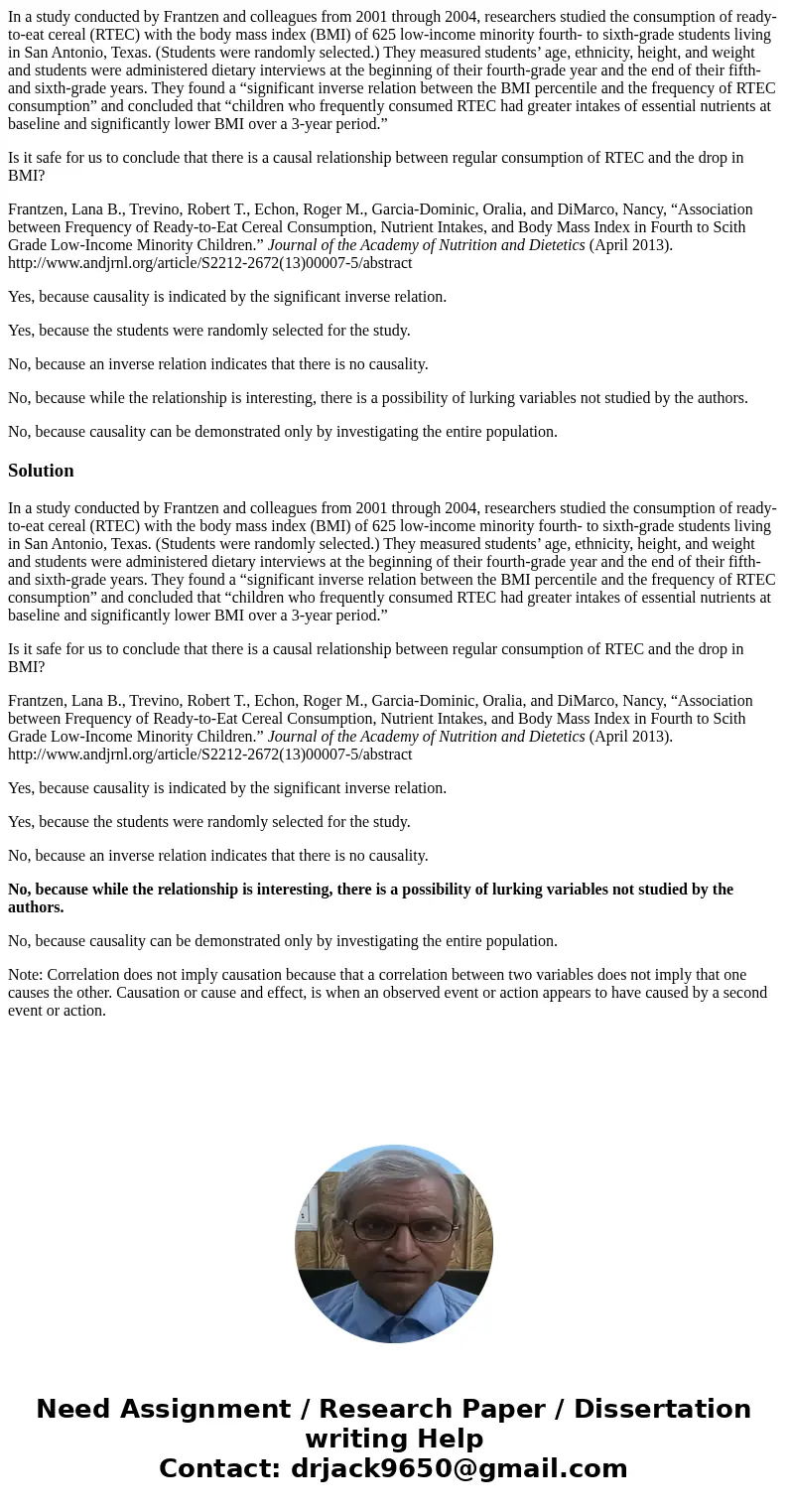In a study conducted by Frantzen and colleagues from 2001 th
In a study conducted by Frantzen and colleagues from 2001 through 2004, researchers studied the consumption of ready-to-eat cereal (RTEC) with the body mass index (BMI) of 625 low-income minority fourth- to sixth-grade students living in San Antonio, Texas. (Students were randomly selected.) They measured students’ age, ethnicity, height, and weight and students were administered dietary interviews at the beginning of their fourth-grade year and the end of their fifth- and sixth-grade years. They found a “significant inverse relation between the BMI percentile and the frequency of RTEC consumption” and concluded that “children who frequently consumed RTEC had greater intakes of essential nutrients at baseline and significantly lower BMI over a 3-year period.”
Is it safe for us to conclude that there is a causal relationship between regular consumption of RTEC and the drop in BMI?
Frantzen, Lana B., Trevino, Robert T., Echon, Roger M., Garcia-Dominic, Oralia, and DiMarco, Nancy, “Association between Frequency of Ready-to-Eat Cereal Consumption, Nutrient Intakes, and Body Mass Index in Fourth to Scith Grade Low-Income Minority Children.” Journal of the Academy of Nutrition and Dietetics (April 2013). http://www.andjrnl.org/article/S2212-2672(13)00007-5/abstract
Yes, because causality is indicated by the significant inverse relation.
Yes, because the students were randomly selected for the study.
No, because an inverse relation indicates that there is no causality.
No, because while the relationship is interesting, there is a possibility of lurking variables not studied by the authors.
No, because causality can be demonstrated only by investigating the entire population.
Solution
In a study conducted by Frantzen and colleagues from 2001 through 2004, researchers studied the consumption of ready-to-eat cereal (RTEC) with the body mass index (BMI) of 625 low-income minority fourth- to sixth-grade students living in San Antonio, Texas. (Students were randomly selected.) They measured students’ age, ethnicity, height, and weight and students were administered dietary interviews at the beginning of their fourth-grade year and the end of their fifth- and sixth-grade years. They found a “significant inverse relation between the BMI percentile and the frequency of RTEC consumption” and concluded that “children who frequently consumed RTEC had greater intakes of essential nutrients at baseline and significantly lower BMI over a 3-year period.”
Is it safe for us to conclude that there is a causal relationship between regular consumption of RTEC and the drop in BMI?
Frantzen, Lana B., Trevino, Robert T., Echon, Roger M., Garcia-Dominic, Oralia, and DiMarco, Nancy, “Association between Frequency of Ready-to-Eat Cereal Consumption, Nutrient Intakes, and Body Mass Index in Fourth to Scith Grade Low-Income Minority Children.” Journal of the Academy of Nutrition and Dietetics (April 2013). http://www.andjrnl.org/article/S2212-2672(13)00007-5/abstract
Yes, because causality is indicated by the significant inverse relation.
Yes, because the students were randomly selected for the study.
No, because an inverse relation indicates that there is no causality.
No, because while the relationship is interesting, there is a possibility of lurking variables not studied by the authors.
No, because causality can be demonstrated only by investigating the entire population.
Note: Correlation does not imply causation because that a correlation between two variables does not imply that one causes the other. Causation or cause and effect, is when an observed event or action appears to have caused by a second event or action.

 Homework Sourse
Homework Sourse